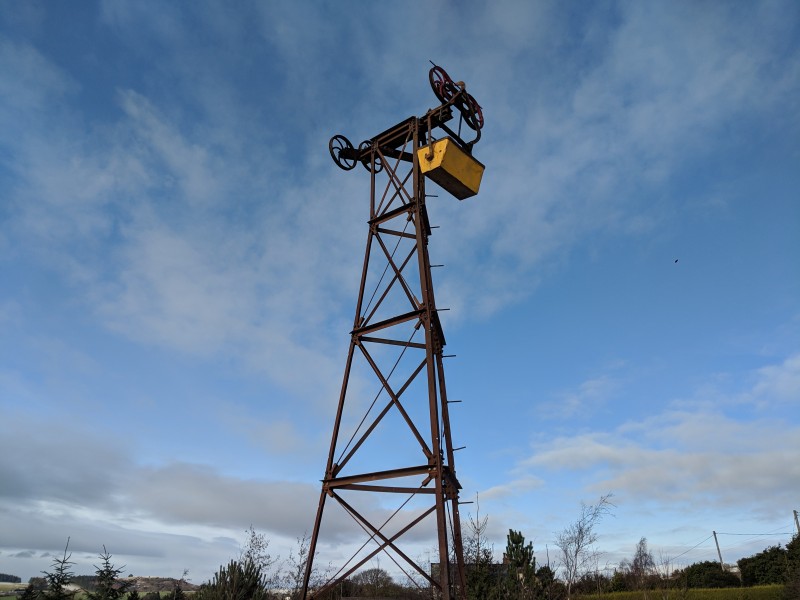The remnants of the mine are minimal, as most were removed in the 1960s for environmental reasons. The tips were repurposed as road stone, shafts were filled, and the last piece of headgear, a wooden frame at Buntings Shaft, was dismantled. The main site is still visible, with some lower walls of The Bog Men’s Club supporting a display on the mine’s history. There are useful interpretation boards to give information to visitors about the mining history of the Bog. Nearby are the overgrown reservoir, the tramway track-bed, and remnants of the ropeway loading point. The gunpowder magazine remains intact, and the Somme Tunnel is accessible, except during bat roosting periods. Former village landmarks, such as the Miners Arms and the school, have been repurposed or are now private properties.
Outcropping lead ore was present at this mine, suggesting potential Roman and pre-Roman mining, though no evidence exists. In the 17th century, local mining was recorded, but old documents lack precise locations. The first mining reference is a 1684 agreement where Rowland Nicchols transferred most of his property, including Ritton and Kinnerton, to his son Orlando, while retaining the right to extract minerals from these lands during his lifetime, provided he continued the work without a break of more than three years. By 1739, Mathew Dore and his company operated the mine, leasing a smelthouse from the London Lead Company. Although the lease ended by 1748, John Lawrence II was involved in the mine by 1760, addressing persistent water issues. In 1789, John Weston and Company installed a steam engine to address the problem, but by 1799, the mine’s activity had declined. Lead mining stopped at The Bog in the 1880s, but the mines were re-opened in the early 1900s to extract barytes.
External Links
Publications (19)
- (1922); BGS - Mineral Resources of GB (c1920s) Vol II - Barytes and Witherite; 136 pages
- (1922); BGS - Mineral Resources of GB (c1920s) Vol XXIII - Lead & Zinc: Pre-Carboniferous Shropshire & North Wales; 111 pages
- (1987); WMS Newsletter Issue 17 Dec; 5 pages
- (1989); WMS Newsletter Issue 21 Dec; 8 pages
- (2003); WMS Newsletter Issue 49 Winter; 32 pages
- Adams, D.R. (1964); PDMHS (Peak District Mines Historical Society) 02-3 May - Survey of the South Shropshire Lead Mining Area Part 2; 11 pages (111-121)
- Barnatt, John (2014); PDMHS (Peak District Mines Historical Society) 19-2 Win - Coal Mining near Buxton - Thatch Marsh, Orchard Common and Goyt's Moss; 91 pages (17-107)
- Brown, Ivor J. (1990); PDMHS (Peak District Mines Historical Society) 11-2 Win - Burgam - Shropshires Last Working Metal Mine, 1957-1963; 5 pages (80-84)
- Brown, Ivor J. (1993); PDMHS (Peak District Mines Historical Society) 12-2 Win - The Buildings and Equipment used at Pennerley Mine, Shropshire, in the late 19th Century, The; 7 pages (50-56)
- Brown, Ivor J. (1995); PDMHS (Peak District Mines Historical Society) 12-5 Sum - Snailbeach Mine and the Disaster of 1895; 6 pages (27-32)
- Brown, Ivor J. (1997); PDMHS (Peak District Mines Historical Society) 13-4 Win - Underground Canals in Shropshire Mines; 7 pages (17-23)
- Gill, M.C.; NMRS (1993); British Mining 46 - Grassington Mines, The; ISBN 0901450 39 1; pp.138.
- NMRS; British Mining 71 - Memoirs 2002; pp.28,38
- NMRS; Memoirs 1969; pp.69,75.
- NMRS; Newsletter May/1983; pp.7.
- NMRS; Newsletter May/1984; pp.3.
- Shaw, Michael (2009); Lead, Copper and Barytes Mines of Shropshire, The
- Shropshire Caving and Mining Club (1979); PDMHS (Peak District Mines Historical Society) 07-4 Oct - An Attempt to Save the Snailbeach Mining Area from Land Reclamation; 4 pages (208-211)
- Williams, R.A.; NMRS (1985); British Mining 26 - Old Mines of the Llangynog District, The; ISBN 0901450 27 8; pp.38.






